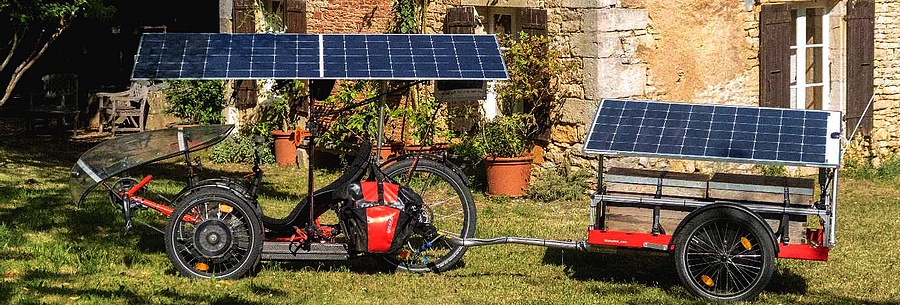
Detailed technical presentation
Specifications
It was relatively simple: solidity, comfort, power and autonomy, to consider long-distance travel. All this with particular care to deal with the four weak points often encountered by suntripers from the start:
1. engine overheating,
2. deficient electrical connectivity in case of excessive rain,
3. structural breakage (frame, luggage rack, solar roof support),
4. broken wheel spokes.
For point 1, it was the choice of distributing the power injected to two Grin Technologies V2 FST (All-Axle front hub) motors + Statorade coolant + heat sinks at Hubsink fins. Maximum power each: 2000 W, total: 4000 W.
Simulation via https://ebikes.ca/tools/simulator.html
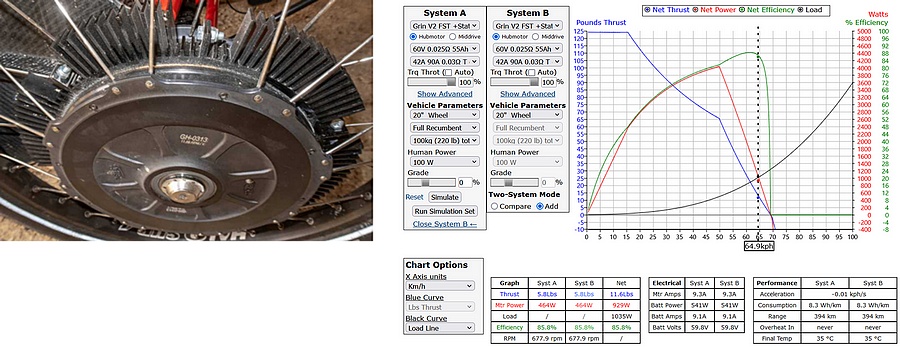
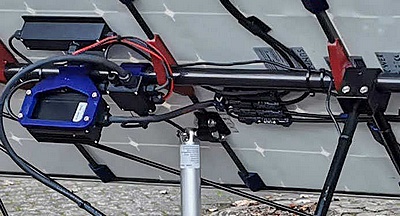
The set allows you to tackle slopes of up to 25° for short periods and 20° for prolonged periods.
For point 2, all connections are sealed. The sensitive boxes are all placed under the bubble.
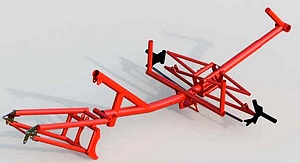
For point 3, the frame, designed using 3D modeling, is made of 4130 CRMO alloy steel. It is TIG welded, cold galvanized (coated with zinc powder after sandblasting and before painting).
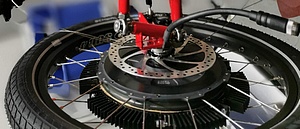
For point 4, choice of large section radii.
Description of the cycle part
- Width: 85 cm tricycle as well as trailer.
- Length: 230 cm (+ 180 cm trailer, total = 4.10 m).
- Wheelbase: 110 cm.
- Turning radius: 4 m.
- Ground clearance: 11 cm.
- Seat height: 21 cm with an adjustable seat angle from 35 to 50 degrees.
- Weight: 53 kg + 9 kg sunroof with its support = 62 kg (without the two panniers).
- Maximum load: 200 kg with pilot and luggage (240 kg with trailer).

- Suspension, Ackermann geometry steering, 17.4 degree kingpin angle, 15 degree caster angle, neutral camber adjustable +/- 5 degrees if required, Kingpin (trailer kingpins cross on the same plane), parallelism with a slight forward toe of 1 degree. Front and rear suspension travel: 13 cm (adjustable).
- SR Suntour 44 pedals, 170 mm, hub with torque sensor.
- Large chainring: 48 teeth, small chainring: 16 teeth.
- Gearbox in the rear wheel hub: Rohloff 500/14, transmission ratio of 526%.
- 20″ front wheels mounted on 20mm axles, 20″ 32h Halo sub-4 rims.
- Schwalbe Big Ben Plus tires with 3mm tough GreenGuard protection. ETRTO dimensions 55-406 (20 x 2.15 Inches).
- “Puncture proof” Tubolito tubes with Presta valve (SV = Sclaverand).
- Front fenders, ¼ wheel, all carbon + mudflaps.
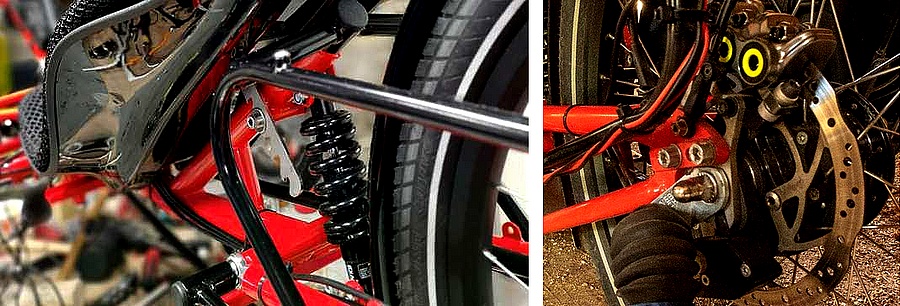
- 26″ rear wheel, Ryde Andra 40 26″ 36h rim.
- Schwalbe Big Ben Plus tires with 3mm heavy duty GreenGuard protection. ETRTO dimensions 55-559 (26 x 2.15 Inches ).
- Linear inner tube (for replacement without removing the wheel) with valve.
- SKS rear mudguard, 53 mm + flap.
- Pressures = 2 to 4 kg or Bar (i.e. 30 to 55 Psi) depending on load, temperature and type of surface.
- Brakes made up of two 180 mm diameter discs at the front, Tektro coupled hydraulics, on front wheels, with contactor and, at the rear, a 180 mm diameter disc, Magura 4-piston MT7 hydraulics, with contactor.All the pads are metallic.
- Electric brake with maximum regenerative power: 1.6 kW.
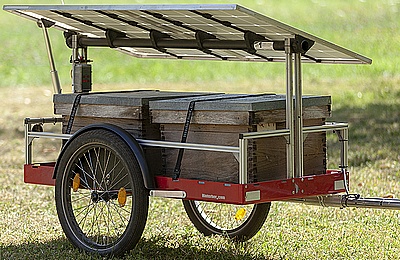
- Hinterher Hxxxl light trailer, CNC machined 4 mm aluminum frame, with 50 cm drawbar extension, 12.9 kg without solarization, max load 65 kg, Weber ES reinforced connection, rigid stainless steel axle equipped with two 20-inch wheels and Schwalbe Super Moto-X tires, 12 V LED rear red light + Garmin red flash radar support and a 220 Wp SunPower solar panel tiltable by electric jack (Ve-Tech solarization by Christophe Bayard)< /li>
Description of the electrical part
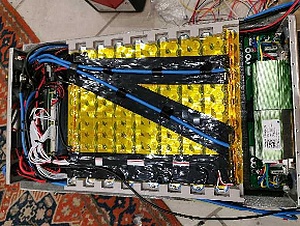
The Lithium-Ion battery is placed under the seat, in a double sealed container (carbon exterior, fiberglass interior). Capacity = 3.3 kWh. BMS (Battery Management System) controlled by the VBMS Android app via Bluetooth.
Weight: 16 kg.
Cell type: Samsung INR21700-50.
Nominal voltage: 3.7 V. Minimum voltage: 2.5 V, before cut-off = 0% SoC (State of Charge).
Capacity: 5 Ah (at slow discharge below a current of 1 A).
Discharge current: 10 A continuous . Maximum discharge current: 15 A. Charge current: 2.5 A.
Charge cycles [80%]: 500.
Density: 272 W/kg.
Pack of 176 cells connected via 100% pure nickel strips and cell blocks via solid copper.
Configuration: 16S11P.
Discharge current: 110A continuous, 165A maximum.
Rated voltage: 60V.< br>Voltage at full load: 67.2 V.
Minimum voltage with cut-off by Cycle Analyst (and BMS): 49 V (= 6% SoC).
Cell balance appears between 65.6 V and 67.2 V.
Maximum load allowed: 28 A.
Satiator charger (never used) from Grin with two configurations:
| Config 1 | Config 2 | |
| Charge à 80 % Full Volts : 63 V Bulk Amps : 5.0 A Complete A : 0.2 Trickle Strt : 35 V Trickle End : 42 V Trickle Amps : 0.5 A | Charge à 100 % Full Volts : 67,2 V Bulk Amps : 5.0 A Complete A : 0.2 A Trickle Strt : 35 V Trickle End : 42 V Trickle Amps : 0.5 A | 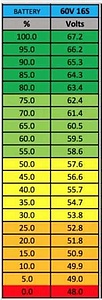 |
On the Sunpower® Flexible SPR-E-Flex-170 tilting solar panel tricycle: 2 x 170 Wp connected in parallel (= 340 Wp), 48 monocrystalline Maxeon® cells, 29.4 V, 5.84 A.
Overall dimension of the solar roof: 207 x 78 cm.
94.7% recyclable, lifespan > 40 years, carbon footprint erased in 14 months.
Each panel generates 29.4V at 5.84A peak, so the combined voltage and current is also 29.4V at 11.68A peak, i.e. 343.4 W peak.
Solar roof support
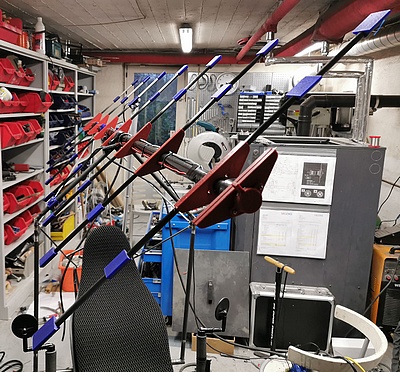
- Useful total of the solar panels, including that of the trailer: 560 Wp (on 2.496 m²).
- Carbon support: 1 central tube of 30 mm x 2 mm and 7 transverse tubes of 10 mm + 3D printed parts glued by 3M double sides.
- 12 V electric actuator for tilting the solar roof (photo A). GoMotorWorld. Input: 12 V. Speed: 17 mm/s. Stroke: 250mm. Thrust = 600 N.
- Actuator controlled either by an Arduino assembly controlled by two cells, or manually by an ON-Left/OFF/ON-Right switch (photo B).
- MPPT supporting Lithium-Ion batteries, output set to a maximum of 66.7 V (photo D)
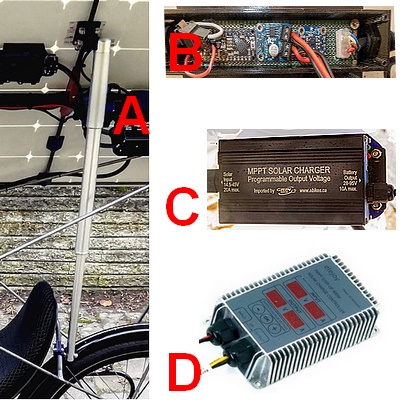
- On the Sunpower® Flexible tilting solar panel trailer: 1 x 220 Wp, 60 monocrystalline Maxeon® cells.
- Overall dimension of the solar roof: 135 x 80 cm.
- 12 V electric actuator for tilting the solar panel. GoMotorWorld. Input: 12 V. Speed: 17 mm/s. Stroke: 250mm. Thrust = 600 N.
- Actuator controlled either by an Arduino assembly controlled by two cells, or manually by an ON-Left/OFF/ON-Right switch (photo B).
- Manual control by ON/OFF/ON switch coupled with that of the tricycle.
- MPPT Boost from GrinTechnologies, 400 W.
Display of electrical data
A hall effect current sensor is connected between the connector and the battery. This allows the charging current to be measured and displayed on the central screen of the Cycle Analyst. The solar charging system is only allowed to charge the battery when the temperature is above 0° Celsius. To continue driving with the solar roof in sub-zero temperature, the main 4-pin solar connector must be disconnected, otherwise the BMS will disconnect the battery when solar charging, causing the motor to lose power.
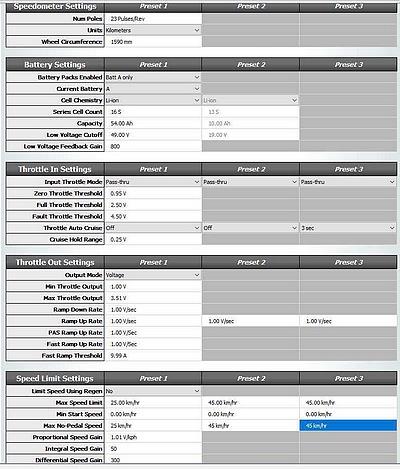
Display and control console: Cycle Analyst v3.13v15, special solar version. Settings:
– low (legal)=250W max, 25km/h max,
– medium=2000W max, 45km/h max,
– high=4000W max, 99 km/h maximum (except for Suntrip trips: 45 km/h).
Data collected by USB cable via PC software “Cycle Analyst Setup Utility” (see table opposite).< /p>

The Data Analogger records the following values on SD card: Ah, V, A, speed, distance, temperature, human RPM, human power, human torque, throttle In, throttle out, auxiliaries digital, Ah solar, A solar and W solar. It can transmit, via an integrated Bluetooth chip, data visible on a smartphone or rugged tablet and interpreted by the Ebike Analizer Android application.
For the motors, two controllersASI BAC 855 TTL BT, 36-72 V, 90 A DC, with heat sinks.
Temperature and speed sensor on left engine only. Configurable (more than 500 parameters) via Bluetooth and the Android application “PC ASI BackDoor2 ” with temporary login + password provided by manufacturer/dealer.
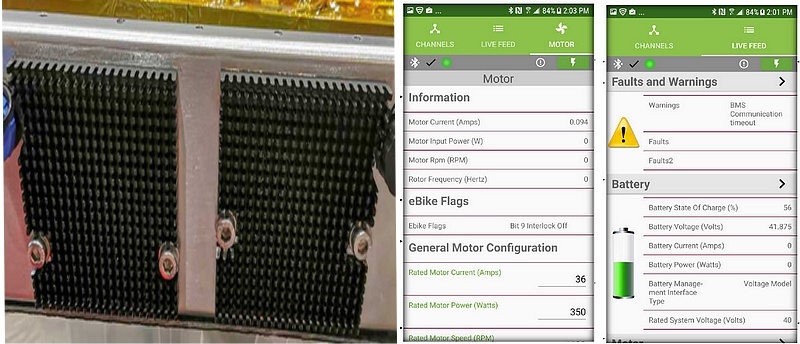
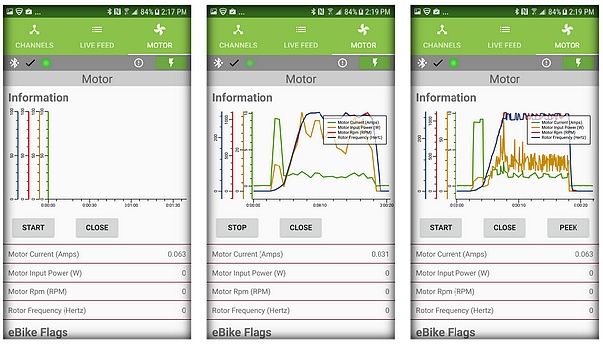
With GrinTechnologies “Phaserunner Suite” software, the screenshot below shows the settings for the left motor.
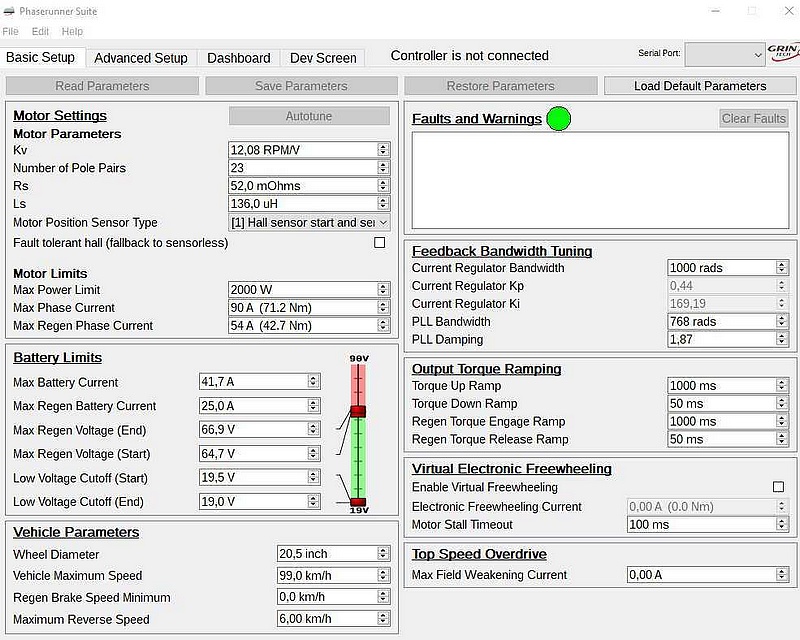
BMS (Battery Management System) intelligent de 200 A avec Bluetooth. La configuration ANT BMS peut être affichée sur smartphone via l’application Android VBMS.
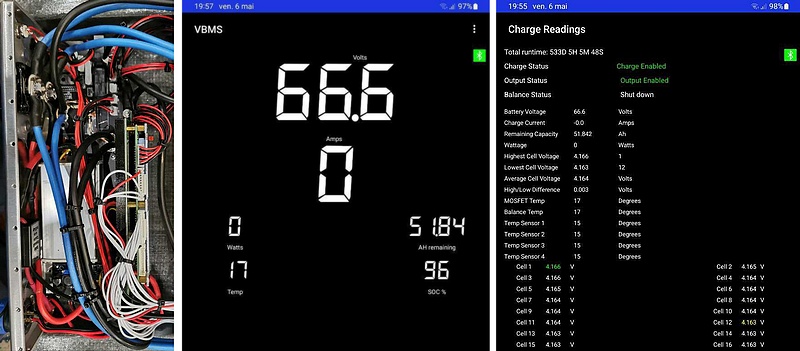
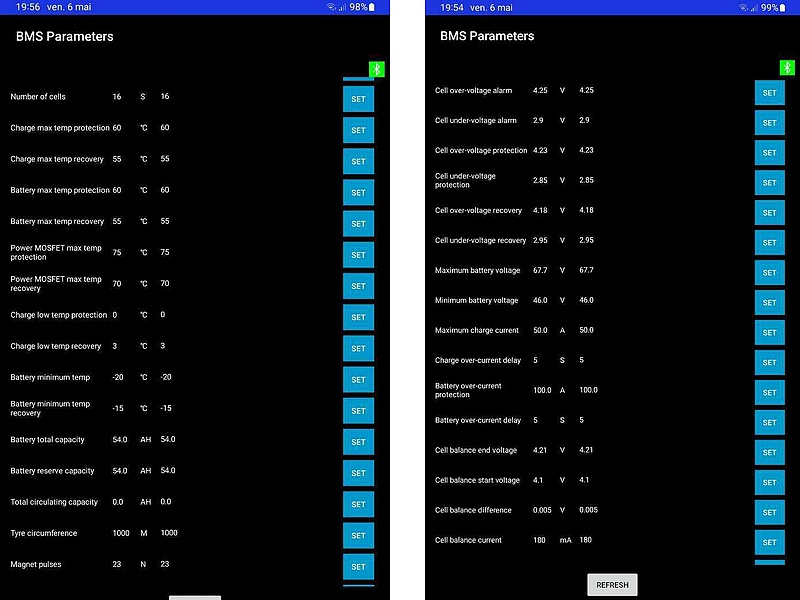
The whole tricycle includes six GPS (Spot beacon, two smartphones, rugged tablet, 360° camera remote control and Data Analogger), five Bluetooth networks (Garmin radar, 2 x motor controllers, BMS, Cycle Analyst) and a network Wifi (between smartphone and rugged tablet). As well as six 5 V USB ports for different charging (smartphones, rugged tablet, Kryptonite flash lights, horn, Spot beacon, Garmin radar).
Security question
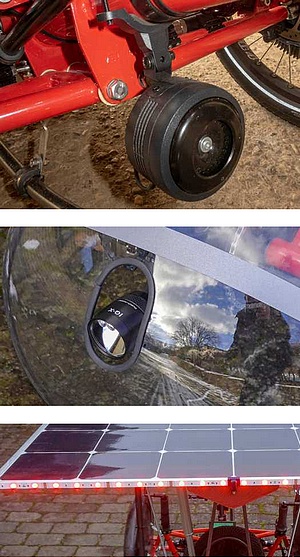
- Garmin RTL515 rear vehicle detection radar and Varia RDU display console;
- Hazard deflector, on left side with front and rear reflectors;
- 12 V B&M IQ-X-E front light and 12 V B&M Toplight E rear light;
- Two Kryptonite red rear flashing lights 75 lumens + two 75 lumens Kryptonite white front flash lights;
- Additional rear light: ramp of 24 red LEDs;
- Two reflectors on the spokes of each of the five wheels (tricycle + trailer );
- Reverse button (speed limited to 6 km/h);
- A yellow fluorescent vest that can be reached instantly;
- Pepper spray can against aggressive dogs;
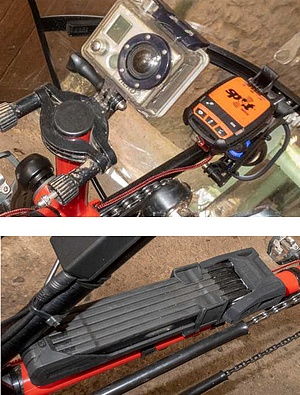
- Satellite distress beacon (+ track tracking on the Internet) Spot Gen3 on Owaka support;
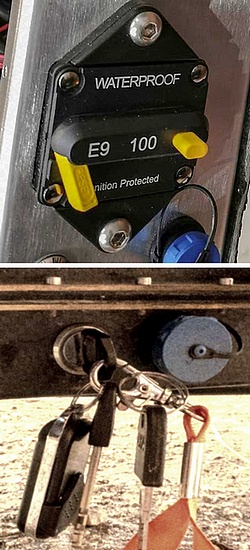
- Abus Bordo Granit X-Plus 6500/110 SH anti-theft;
- Casco Speed’Air 2RS helmet;
- IcaBike anti-theft identification;
- Headrest;
- Two mirrors, right and left;
- General switch / circuit breaker 100 A from the battery.
- Ignition key.
Feedback
Problems Encountered:
- Breakage of two 3D parts of the solar roof support, redone with a higher percentage of material.
- Ditto for the rear red light support.
- Guard – rear mud split in two places, replaced.
- Reinforcement for the triangular fixing of the solar panel of the trailer.
In short, almost nothing considering more than 7,000 km sometimes on rough roads or paths.
Maximum reliability of frames, motors and electrical and electronic installations. Zero problem!
No mains load since start. Possibility to do more than 400 km per sunny day. Suntrip Breizh 2021 (lots of rain) and Suntrip Alpes 2022 (lots of elevation) without problem. For the latter, see the file of all the statistics collected via the Data Analogger.
Great comfort provided by the “full suspension”, no fatigue or back pain.
Machine designed to go around the world… whose price is just over €13,000 (without the trailer).
My next machine
The one described above!

Related documents
Appendix 0: Data collected by the Data Box during the Sun Trip 2022
Appendix 1 – Arduino Programming of automatic solar panel tilt
